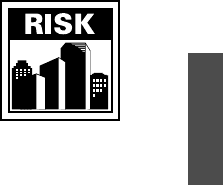Richard A. Caralli, Julia H. Allen, David W. White. CERT Resilience Management Model
Подождите немного. Документ загружается.


717
RISK MANAGEMENT
Enterprise
Purpose
The purpose of Risk Management is to identify, analyze, and mitigate risks to
organizational assets that could adversely affect the operation and delivery of
services.
Introductory Notes
Risk management is a basic and essential organizational capability. The organiza-
tion must identify, analyze, and mitigate risk commensurate with its risk toler-
ances and appetite to ensure that it prevents potential disruptions that could
interfere with its ability to meet its mission. At a tactical level, to accomplish this
goal, the organization must control operational risk—the risk that results from
operating services and associated assets on a day-to-day basis. Operational risk
encompasses the potential impact that could result from
• failed internal processes
• inadvertent or deliberate actions of people
• problems with systems or technology
• external events
Managing operational risk significantly influences operational resilience. The
risk of disruption to any asset potentially renders associated services unable to
meet their mission, hence reducing operational resilience. The organization must
identify this risk, analyze it, and determine the extent to which it could affect
operations. Mitigating such risk requires a careful balance between strategies for
protecting and sustaining assets and services while considering the cost of these
strategies and the value of the assets and services to the organization.
The Risk Management process area establishes the organization’s responsibility
to develop and implement an operational risk management plan and program
that comprehensively and cooperatively cover the high-value assets and services
RISK

of the organization. The organization explicitly establishes its risk tolerances and
appetite based on its strategic drivers, market position, competitive environment,
financial position, and other factors. With this appetite as a guide, risks to the
assets of the organization are periodically identified, analyzed, and categorized,
and mitigation strategies are developed and implemented for those risks that the
organization cannot afford to ignore. The impact of risk is considered and meas-
ured against the organization’s risk evaluation criteria. Most important, the infor-
mation gathered in risk assessment can be used to improve the effectiveness of
strategies to protect and sustain assets and services.
All uses of “risk” in Risk Management refer to operational risk, specifically,
risk to the operation and delivery of services. Other risk categories are beyond
the scope of this process area.
Related Process Areas
The identification of vulnerabilities that may pose risk to the organization is performed in the
Vulnerability Analysis and Resolution process area.
The development and implementation of control strategies to mitigate risk are performed in
the Controls Management process area.
The development, testing, and implementation of service continuity plans to address the
consequences of realized risk are performed in the Service Continuity process area.
Summary of Specific Goals and Practices
RISK:SG1 Prepare for Risk Management
RISK:SG1.SP1 Determine Risk Sources and Categories
RISK:SG1.SP2 Establish an Operational Risk Management Strategy
RISK:SG2 Establish Risk Parameters and Focus
RISK:SG2.SP1 Define Risk Parameters
RISK:SG2.SP2 Establish Risk Measurement Criteria
RISK:SG3 Identify Risk
RISK:SG3.SP1 Identify Asset-Level Risks
RISK:SG3.SP2 Identify Service-Level Risks
RISK:SG4 Analyze Risk
RISK:SG4.SP1 Evaluate Risk
RISK:SG4.SP2 Categorize and Prioritize Risk
RISK:SG4.SP3 Assign Risk Disposition
RISK:SG5 Mitigate and Control Risk
RISK:SG5.SP1 Develop Risk Mitigation Plans
RISK:SG5.SP2 Implement Risk Strategies
RISK:SG6 Use Risk Information to Manage Resilience
RISK:SG6.SP1 Review and Adjust Strategies to Protect Assets and Services
RISK:SG6.SP2 Review and Adjust Strategies to Sustain Services
718 PART THREE CERT-RMM PROCESS AREAS

Specific Practices by Goal
RISK:SG1 PREPARE FOR RISK MANAGEMENT
Preparation for risk management is performed.
Preparation for operational risk management requires the organization to
develop and maintain a strategy for identifying, analyzing, and mitigating opera-
tional risks. This strategy is documented in a risk management plan and
addresses the activities that the organization performs enterprise-wide to carry
out a continuous risk management program. This includes identifying the
sources and types of operational risk and establishing a strategy that details the
organization’s approach, activities, and objectives for managing these risks as a
fundamental operational resilience management process.
RISK:SG1.SP1 DETERMINE RISK SOURCES AND CATEGORIES
The sources of risk to assets and services are identified and the categories of risk that are
relevant to the organization are determined.
Identifying risk sources helps the organization to determine and categorize the
types of operational risk that are most likely to affect day-to-day operations and
to seed an organization-specific risk taxonomy that can be used as a tool for man-
aging risk on a continuous basis as operating conditions change and evolve. The
sources of risk can be both internal and external to the organization.
Categorizing operational risks provides the organization a means by which to
perform advanced analysis and mitigation activities that allow for similar types
of risks to be effectively neutralized or contained by limited actions by the
organization.
Ty p i c a l w o r k p r o d u c t s
1. Operational risk sources list
2. Operational risk categories list
3. Operational risk taxonomy
Subpractices
1. Determine operational risk sources.
Risk sources are the fundamental areas of risk that can affect organizational services
and associated assets while they are in operation to meet the organization’s mission.
Risk sources represent common areas where risks may originate. Typical internal
and external sources include
• poorly designed and executed business processes and services
• inadvertent actions of people, such as accidental disclosures or modifications of
information
Risk Management 719
RISK

• intentional actions of people, such as insider threat and fraud
• failure of systems to perform as intended, or risks posed by the complexity and
unpredictability of interconnected systems
• failures of technology, such as the unanticipated results of the execution of
software and the failure of hardware components such as servers and
telecommunications
• external events and forces, such as natural disasters, failures of public infrastruc-
ture, and failures in the organization’s supply chain
Advance definition of specific risk sources for the organization provides a means for
early identification of risk and can seed mitigation plans that can cover a broad array
of operational risks before the organization realizes the consequences of these risks.
2. Determine operational risk categories.
Risk categories provide a means for collecting and organizing risk for ease of
analysis and mitigation. Typical operational risk categories align with the various
sources of operational risk such as failed processes, actions of people, systems and
technology, and external events but can be as granular as necessary for the organi-
zation to effectively manage risk. Operational risks may also align with the types
of assets they are most likely to affect—risks to the availability of people, the
confidentiality, integrity, and availability of information, etc.
3. Create an operational risk taxonomy.
An organization-specific risk taxonomy is a way to collect and catalog common
operational risks that the organization is subject to and must manage. The risk
taxonomy is a means for communicating these risks and for developing organiza-
tional unit and line-of-business–specific mitigation actions if operational assets and
services are affected by them.
RISK:SG1.SP2 ESTABLISH AN OPERATIONAL RISK MANAGEMENT STRATEGY
A strategy for managing operational risk relative to strategic objectives is established
and maintained.
Because of the pervasive nature of operational risk, a comprehensive operational
risk management strategy is needed to ensure proper consideration of risk and the
effects on operational resilience. The strategy provides a common foundation for
the performance of operational risk management activities (which are typically dis-
persed throughout the organization) and for the collection, coordination, and ele-
vation of operational risk to the organization’s enterprise risk management process.
Ty p i c a l i t e m s a d d r e s s e d i n a n o p e r a t i o n a l r i s k m a n a g e m e n t s t r a t e g y i n c l u d e
• the scope of operational risk management activities
• the methods to be used for operational risk identification, analysis, mitigation,
monitoring, and communication
• the sources of operational risk
• how the sources of operational risk should be organized, categorized, compared,
and consolidated
720 PART THREE CERT-RMM PROCESS AREAS

• parameters for measuring and taking action on operational risks
• risk mitigation techniques to be used, such as the development of layered
administrative, technical, and physical controls and the development of service
continuity plans
• definition of risk measures to monitor the status of the operational risks
• time intervals for risk monitoring and reassessment
• staff involved in operational risk management and the extent of their involvement
in the activities noted above
The operational risk management strategy should be developed to facilitate
the accumulation of operational risks as input to the organization’s enterprise
risk management strategy and program. The strategy should be documented and
communicated to all relevant stakeholders, internal and external, that are respon-
sible for any operational risk management activity.
Ty p i c a l w o r k p r o d u c t s
1. Operational risk management strategy
Subpractices
1. Develop and document an operational risk management strategy that aligns with
the organization’s overall enterprise risk management strategy.
2. Communicate the operational risk management strategy to relevant stakeholders
and obtain their commitment to the activities.
RISK:SG2 ESTABLISH RISK PARAMETERS AND FOCUS
Risk tolerances are identified and documented and the focus of risk management activities
is established.
Risk parameters help the organization to establish a foundation for consistent
risk consideration and measurement. Risk parameters reflect the organiza-
tion’s stated risk tolerances and appetite and ensure that there is consistent
measurement of operational risk across the organization. They provide
common and consistent criteria for comparing risks and for characterizing the
severity of consequences to the organization if risk is realized. This facilitates
the organization’s process for prioritizing risk and for developing mitigation
strategies.
RISK:SG2.SP1 DEFINE RISK PARAMETERS
The organization’s risk parameters are defined.
Risk parameters provide the organization a means for consistent measurement of
operational risk across the organization. The establishment of risk tolerance
Risk Management 721
RISK

thresholds, in particular, reflects the organization’s level of risk adversity by
providing levels of acceptable risk in each operational risk category that the
organization establishes. Risk parameters also establish the organization’s philos-
ophy on risk management—how risks will be controlled, who is authorized to
accept risk on behalf of the organization, and how often and to what degree oper-
ational risk should be assessed.
Ty p i c a l w o r k p r o d u c t s
1. Operational risk thresholds
2. Risk management requirements
Subpractices
1. Define risk thresholds for each risk category.
Risk thresholds are a management tool to determine when risk is in control or has
exceeded acceptable organizational limits. They must be set for each category of
operational risk that the organization establishes as a means for measuring and
managing risk. For example, a risk threshold for virus intrusions may be whenever
more than 200 users are affected; this would indicate that management needs to
act to prevent operational disruption.
2. Establish risk management parameters.
RISK:SG2.SP2 ESTABLISH RISK MEASUREMENT CRITERIA
Criteria for measuring the organizational impact of realized risk are established.
A specific type of risk parameter that requires the organization’s attention is risk
measurement criteria. Risk measurement criteria are objective criteria that the
organization uses for evaluating, categorizing, and prioritizing operational risks.
Without these criteria, the organization would have a difficult time consistently
gauging the potential effect that an operational risk could have on one or more
important impact areas for the organization.
Ty p i c a l w o r k p r o d u c t s
1. Organizational impact areas
2. Risk measurement criteria
Subpractices
1. Define organizational impact areas.
Organizational impact areas identify the categories where realized risk may have
meaningful and disruptive consequences. These areas typify what is important to
the organization and to the accomplishment of its mission.
722 PART THREE CERT-RMM PROCESS AREAS

2. Prioritize impact areas for the organization.
The prioritization of impact areas allows the organization to determine the relative
importance of these areas to allow them to be used for risk prioritization and
mitigation.
3. Define and document risk measurement and evaluation criteria.
Risk measurement and evaluation criteria provide the bounds on the severity of
consequences to the organization across the organizationally defined impact areas.
The consistent application of these criteria across all operational risks ensures that
risks are prioritized according to organizational importance (even if they are spe-
cific to an organizational unit or line of business) and are mitigated accordingly.
The range of criteria can be either qualitative (high, medium, low) or quantitative
(based on levels of loss, fines, number of customers lost, etc.).
4. Define and document risk likelihood.
While risk probability may be difficult to establish for operational risks, the organi-
zation should establish parameters for risk probability that are used to further
guide risk prioritization and mitigation. These parameters can be qualitative (high,
medium, or low) or quantitative (based on experience where available).
RISK:SG3 IDENTIFY RISK
Operational risks are identified.
The level and extent of operational risks to which the organization is subjected
directly affect the organization’s operational resilience. A key activity in manag-
ing and controlling operational resilience is the identification of operational risk
and the mitigation of this risk before the organization is subjected to the conse-
quences of realized risk.
RISK:SG3.SP1 IDENTIFY ASSET-LEVEL RISKS
Operational risks that affect assets that support services are identified.
Operational risks that can affect assets such as people, information, technology,
and facilities must be identified and mitigated in order to actively manage the
These are examples of organizational impact areas:
• reputation and customer confidence
• financial health and stability
• staff productivity
• safety and health of staff and customers
• fines and legal penalties
• compliance with regulations
Risk Management 723
RISK

operational resilience of these assets and, more important, the services to which
these assets are connected.
Risk identification is a foundational risk management activity. It requires the
organization to identify and assess the types and extent of threats, vulnerabilities,
and disruptive events that can pose risk to the operational capacity of assets and
services. It is not an attempt to identify all operational risks, but only those that
have meaning in the context of the categories of risk and the risk parameters
established by the organization. Identified risks form a baseline from which a
continuous risk management process can be established and managed.
There are many techniques that can be used to identify risk, such as
• using questionnaires and surveys
• interviewing vital managers and subject matter experts
• review of process controls
• using tools, techniques, and methodologies, such as information security risk
assessments
• performing internal audits and performance reviews
• performing business impact analysis
• performing scenario planning and analysis
• using risk taxonomies for similar organizations and industries
• using lessons-learned databases, such as the incident knowledgebase
• reviewing vulnerability catalogs, such as the US-CERT Vulnerability Notes
Database and MITRE’s Common Vulnerabilities and Exposures (CVE) project
The identification of vulnerabilities that may pose risk to the organization is performed in the
Vulnerability Analysis and Resolution process area. The activities performed in this process
area can be used as a source for seeding a list of operational risks.
Ty p i c a l w o r k p r o d u c t s
1. Organizational risk identification toolkit
2. List of operational risks, by asset category
Subpractices
1. Identify the tools, techniques, and methods that the organization can use to
identify operational risks to organizational assets.
Ensure that these tools, techniques, and methods are accessible to staff and that
appropriate training is available.
2. Identify the operational risks (at the asset level) that can negatively impact
high-value organizational services.
724 PART THREE CERT-RMM PROCESS AREAS

3. Develop risk statements.
Develop risk statements that clearly articulate the context, conditions, and
consequences of the risk.
Consequences resulting from realized risk should be described relative to the
impact areas that the organization defined as part of defining risk measurement
criteria. (For example, consequences should be articulated in terms of how the
organization’s reputation is affected, or if any fines and legal penalties result.)
4. Identify the relevant stakeholders associated with each documented risk.
RISK:SG3.SP2 IDENTIFY SERVICE-LEVEL RISKS
Operational risks that potentially affect services as a result of asset risk are identified.
The disruption of asset productivity due to operational risk affects the ability of
associated services to meet their mission. Thus, risks associated with organiza-
tional assets must be examined in the context of these services to determine if
there is a potential impact on mission assurance, which in turn could affect the
organization’s ability to meet its mission. Examining risk in the context of ser-
vices provides the organization additional information that must be considered
when prioritizing risks for disposition and mitigation.
The identification of high-value services is performed in the Enterprise Focus process area.
The association of services to their associated assets is performed in the Asset Definition and
Management process area. Relevant practices in these process areas must be performed before
operational risks can be examined in a service context.
Ty p i c a l w o r k p r o d u c t s
1. Updated risk statements, with service context and consequences
2. List of operational risks, by service
Risk statements should include information about
• the asset affected (people, information, technology, or facilities)
• a weakness or vulnerability of the asset that could be exploited
• actors who would exploit the weakness
• the means that an actor would use
• the motive of the actor
• the undesired outcome
• resilience requirements that would be affected by the risk
• the likelihood (if known) of the risk being realized
• the consequences to the organization of the undesired outcome
• the severity of the consequences (as measured by applying risk measurement
criteria)
Risk Management 725
RISK

Subpractices
1. Identify the services that are associated with each asset-specific risk statement.
Update the risk statement to reflect associated services.
2. Determine the effect on the service that could result from the realization of risk
at the asset level.
3. Update risk statement information to reflect service-specific consequences and
the severity of the consequences due to realized risk.
RISK:SG4 ANALYZE RISK
Risks are analyzed to determine priority and importance.
Risk analysis is performed by the organization to determine the relative impor-
tance of each identified operational risk and is used to facilitate the organization’s
risk disposition and mitigation activities. Risk analysis helps the organization to
place identified risks in the context of the organization’s risk drivers (tolerances,
appetite, and measurement criteria), which further facilitates mitigation planning.
RISK:SG4.SP1 EVALUATE RISK
Risks are evaluated against risk tolerances and criteria, and the potential impact of risk
is characterized.
To d et er mi ne t he e x te nt o f t he o pe ra ti o na l r is k, t he c on se q ue nc es o f t he r is k
must be evaluated using the organization’s risk measurement criteria. Not all
risks are the same for all organizations; what might be a major concern for one
organization might be minor for another for many reasons, such as financial sol-
vency, market position, cash reserves, and industry. Using the organization’s risk
measurement criteria for valuation ensures that the risks that are most important
to the organization’s unique operating circumstances are prioritized higher than
those that do not directly impact organizational drivers.
Ty p i c a l w o r k p r o d u c t s
1. Updated risk statements with impact valuation
Subpractices
1. Evaluate the identified risks using the defined risk parameters and risk
measurement criteria.
Each risk is evaluated and assigned values in accordance with the defined risk
parameters and risk measurement criteria. (These include likelihood, consequence,
consequence severity, and thresholds.) The organization may weight the valuation
of the risks by adjusting for the priority of impact areas (reputation, finance, etc.)
that it established as part of the risk measurement criteria. This will ensure that
impact areas of most importance to the organization will influence more strongly
726 PART THREE CERT-RMM PROCESS AREAS
